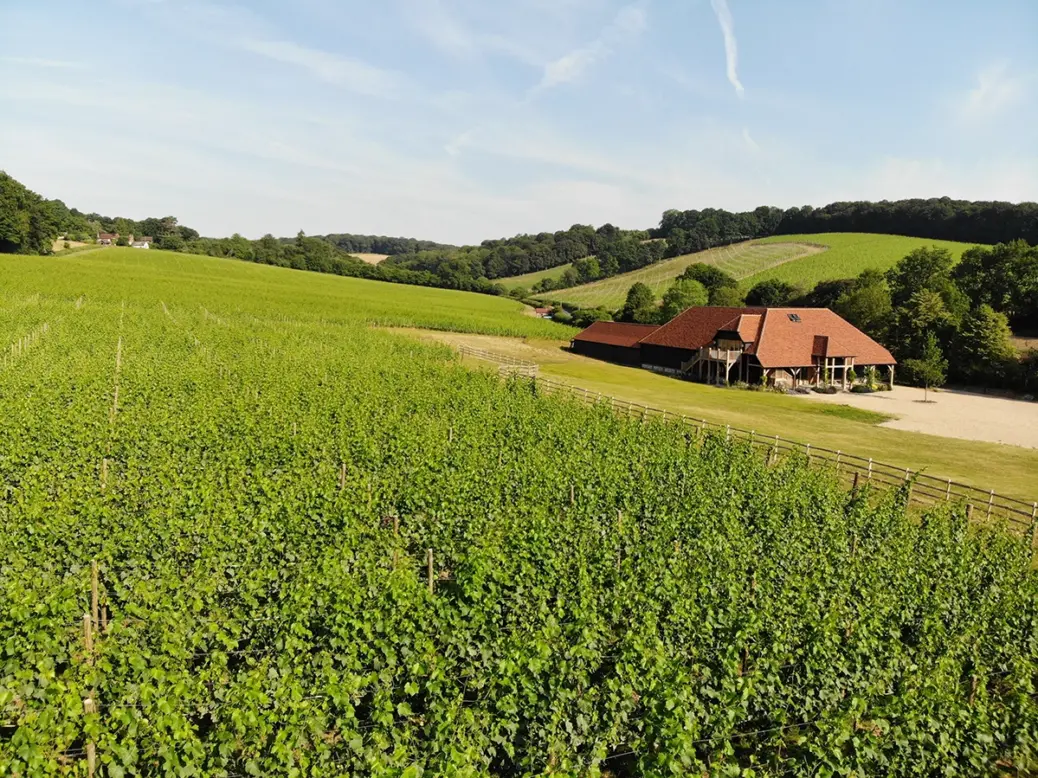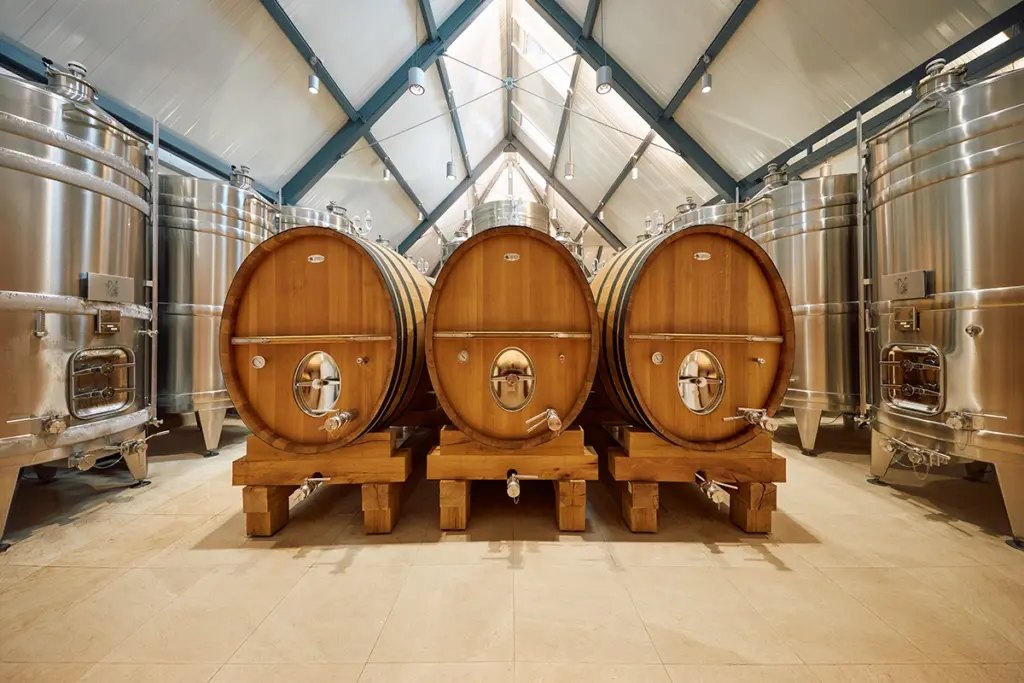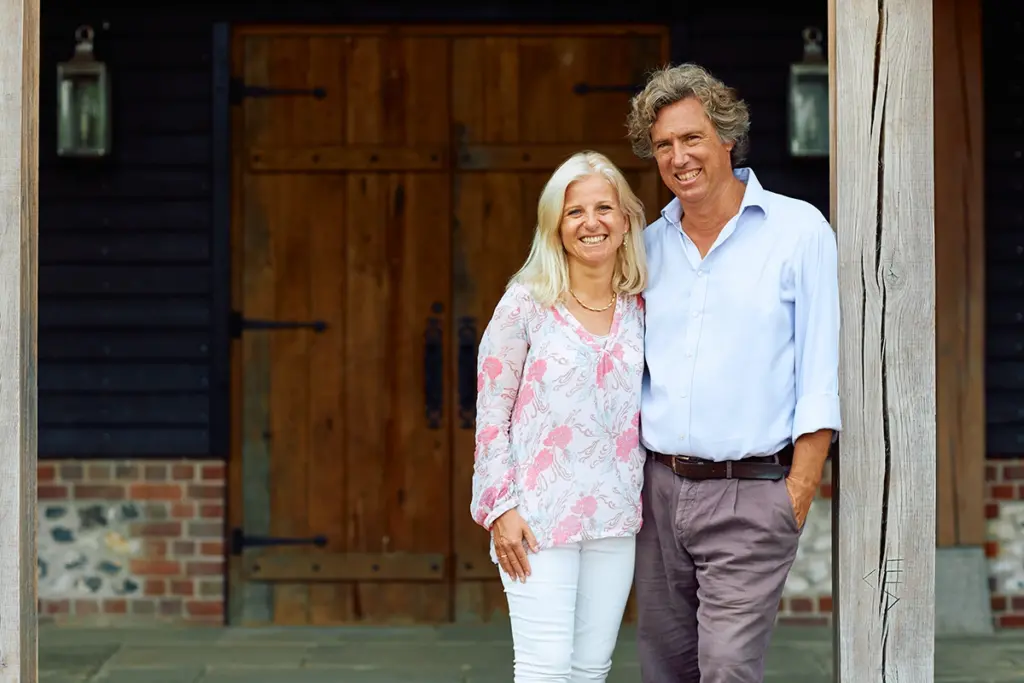
Stephen and Fiona Duckett’s meticulous search for the perfect site to make sparkling wine led them to ten parcels of steep chalk slopes in Oxfordshire. Margaret Rand admires the view of the couple’s discreetly impressive Hundred Hills estate.
Okay, let’s get the obvious stuff out of the way first. What’s a hundred? One more than 99. Thank you. Any other ideas? Shall we ask the medievalist at the back? Yes: it is an administrative area. Exactly. Bigger than a village, and smaller than a shire, so quite big. And this particular hundred had hills. Steep hills. Steep enough for you to look forward to getting to the top and having a breather, when you’re marching up them with Stephen and Fiona Duckett, who obviously march up them every day and so can talk at the same time. “It’s a concave slope,” says Stephen. “We got this couple from Poland who specialize in planting concave and convex slopes. They go all over Europe, just planting concave and convex slopes.”
Slopes were crucial to the Ducketts’ plans when they decided on wine as a second career. They had to be chalk slopes, and steep for obvious reasons. As a rule of thumb, if a slope they were inspecting had crops on it, it was too fertile. If it had horses on it, it wasn’t steep enough. They looked at about 300 sites in the south of England, and they had the soil in 100 of them analyzed in the labs of the Comité Interprofessionnel du vin de Champagne (CIVC). And here we are: slightly breathless, but with a great view.
All this begs several questions. Who are these Ducketts? And how come they could just march into the CIVC labs? Well, they couldn’t. But Michel Salgues could. He was professor of enology at Montpellier (where, as an aside, he had taught Roederer chef de cave Jean-Baptiste Lécaillon), and the Ducketts had found him when they were looking for the right person to advise them on buying the right land and planting it.
And the Ducketts? Oh, just your average tech millionaires, you know. To be precise, Stephen comes from a family of farmers on the Somerset Levels. He was always fascinated by computers, and in about 1982, his parents “took the difficult decision” to buy him an early computer; “it turned out to be a good investment,” he says. “When I got to Oxford, we were all fighting to get to the few mainframe computers,” but he learned how to strip data from mainframes into smaller computers. He and Fiona met at Oxford—they were both at Hertford College, where she was reading French and Russian. His course was engineering, economics, and management, and he went into building software and Internet companies in Europe and the US. It was a bottle of 1992 Nyetimber, brought to them by a friend, that sparked their interest in English wine. It was, says Stephen, “better than I expected.”

Hundred Hills: Meticulous attention to detail
That may not sound the most extravagant praise, but English fizz has come an awfully long way over the past 20 years, not least because of climate change. “It took a couple of years for the penny to drop [with us] on climate change,” says Stephen. “In the growing season, here, it’s now 2ºC [3.6ºF] warmer than in the 1970s.” And climate, as we will see, dictated a great many of their decisions.
Over the next couple of years after tasting that Nyetimber, they traveled a lot and talked of working together. Which led to the search for the right consultant and, eventually, to ten parcels of steep chalk slopes, all sufficiently and deliberately separate from each other to give differences in ripening times and styles. Nothing about Hundred Hills happened by accident.
Most of it happened, in fact, because of data. “I have a very technical background,” says Stephen. “I like to have a lot of data.” There are lots of sensors in the vineyards, and he’s now involved in a research project with Oxford University that analyzes satellite data and compares it with ground data on such matters as water availability and carbon sequestration; it’s a project that could benefit small vineyards that can’t afford the capital investment to get that information themselves.
It was climate data and soil data that eventually brought the Ducketts to Hundred Hills. It is sheltered, but breezy enough to keep things healthy; and it’s not frost-prone, which is important once you move away from the coast. They have frost fans in some places, but even in frost-hit 2020 they had only minor problems on some valley floors, says Stephen. And the upside of being away from the sea is, he says, drier autumns. The soil is thin and poor; gratifyingly, the CIVC had wanted to know where on the Côte des Blancs it was from. The property wasn’t actually for sale, but it had been on the market before, so they felt they could negotiate. Obviously, they were successful. Vines were sourced from nurseries in Burgundy that had the same clones that were grown in Champagne in the 1960s and ’70s; because of the similarities of climate between the Côte des Blancs then and this corner of Oxfordshire now, Stephen reckoned they would work. They did a three-day study session at the nursery; the nursery had never done anything in England before, but it seems to have taken on the project with enthusiasm. Different clones were selected for different spots. They started planting in 2014: 65,000 vines over four days, starting as the sun came up.
They were planting for a particular size of project—“an efficient size,” says Stephen. They have 42 acres (17ha) under vine, and “between 30 and 50 acres [12–20ha] is the sweet spot. If you’re above that, you’re dealing with multiples, and it’s a very different type of business. I have dealt with supermarkets in the past, and I don’t intend to do so again. But if you’re too small, you can’t afford the kit you need.”
Living countryside
The Ducketts had to build, of course. There was a barn on the Hundred Hills site, but they needed a winery and hospitality facilities (of which more later); they also wanted to build a house for themselves, even though this project is on hold at the moment. Agonizing over bathrooms while they were still getting the winery off the ground seemed a particularly refined form of torture; so they still commute from central Oxford.

Oxfordshire County Council is, says Stephen, known to have a very tough planning department. So they started a general softening-up campaign: They talked to the neighbors, they mentioned the varied and high-end jobs that would be available, they focused on the benefits of “living countryside” (it’s in an Area of Outstanding Natural Beauty, with strict planning guidelines), and they produced, they say, some very beautiful drawings. And they got their planning consent.
What they have built is a pair of picture-perfect Chiltern barns, tucked into a valley. If you didn’t know, you’d assume they’d been there for hundreds of years. Swallows nest under the eaves, and there are downland wildflowers between buildings and vineyards. There are bluebells in the beech woods and hares in the vines. “There has never been a herbicide on this land,” they say. The vineyards are all carbon-neutral, says Stephen: “Easy to say, but hard to do.” There is no plowing; just some hoeing under the vines, so everything is green, with the grass kept fairly short.
These are all young wines from young vines, but they have real concentration, from ripe fruit and low yields. Yields are 5–7 tonnes per hectare, maybe 8 tonnes from one particular clone of Pinot Noir—much lower than Champagne, of course, but remember that planting densities in England, at about 5,000 vines per hectare, are about half those of Champagne.
The Ducketts had expected one year in five to be a write-off, and two years in five to be difficult. Instead—well, that just hasn’t happened. “The main surprise is that year after year it’s been good,” says Stephen. “It’s down to hard work, yes, but climate change, too.” They make only Vintage wine and don’t intend to change that. They focus on picking as late as possible, usually at around 10.3% potential alcohol, and cut the secondary buds off before harvest, to prevent any possible confusion. They will sometimes make two passes, picking the top of a parcel and then the bottom; they will usually have between 20 and 30 base wines. One of the ways Salgues felt he could make a difference most quickly, says Stephen, was in ensuring that the grapes were pressed as quickly as possible, and that’s what happens.
There is oak, in a range of different toasts; fermentation is in steel; and all wines get at least two and up to five years on the lees, though Stephen doesn’t think the lees give much after two years, and he would rather have them under a cork after that. Different parcels go into different wines—a map on each label shows which parcels it came from—and consistency is not the aim. Instead, it’s about seizing the opportunities of each year—and laying down wines in a library.
All along, Salgues’s input was crucial. “It was a bit of a love affair for him,” says Stephen. “He understood what we wanted, and he was committed to it. He came over three, four, or five times a year.” And though he’d lived in the US for many years, he liked being able to speak French with Fiona. Salgues died a few years ago, and now another taster from Champagne comes over when they’re blending; but again, they learned about base wines from Salgues, who enabled them to taste vins clairs all over Champagne and understand how they behave.
Their first vintage was 2016. They hadn’t intended to pick at all, but in the end they did a two-day harvest. The wine—called Preamble—still tastes young. Very elegant, green-apple notes, and taut. In 2017, there were two Preambles, numbers 1 and 2, the latter having been picked as late as possible, in the last days of October. It’s a beautiful wine, precise and energetic. It’s the house pour at the Manoir aux Quat’Saisons. In 2018, they made a zero dosage, having said they would never do such a thing; but, they say, dosage just didn’t improve it. Even so, they made another version of the same wine with 4g/l of dosage, and they sell the two wines boxed together. There’s a rosé and a rosé saignée, the latter aged in small oak barrels and made only from the very ripest bunch on each vine; it’s a weighty, punchy wine with flavors of eucalyptus and rose hip. There’s Hillside No. 3, which came in 2019 from a very late picking of all the bunches that were left. With full malo and 5g/l dosage, it is a beautiful example of richness and poise. A lot of restaurants serve it with panna cotta, apparently. There’s also a slightly higher-dosage, very approachable wine called Doe Eyed Queen, which has no hyphen because it is aimed at a post-punctuation generation—the generation of the Ducketts’ daughter Amy, who works in the business doing social media and events. (Unless the name is really intended to mean that a deer watched a royal.) Doe Eyed Queen apparently goes down a bomb at Oxford colleges, in the Cotswolds, and beyond.
None of these wines, however, will be available at a merchant near you—unless you happen to live near one of the very small handful of independent merchants who are allowed some. Otherwise, it goes to restaurants, Oxford colleges, and Hundred Hills’ own wine club. It’s a sales model taken from Napa, and it is based on constant communication with customers and a lot of visits to the winery. The Manoir lends a chef to cook for these events, which might be dinners for club members, or corporate or charity dos, but all high-end. There’s a lot of food matching, as is the way for sparkling wine now—and quite rightly.
The Ducketts do not intend to get bigger. Better, year by year, yes, but not bigger. They will have their own brand of water, they say, but they don’t expand on that. Instead, they focus on the regenerative effect a good business can have on other businesses. “It’s sustainability, the quality of the wines, the preservation of the English countryside,” they say.
And it’s all come from their own funds. Just your average tech millionaires—or not.






